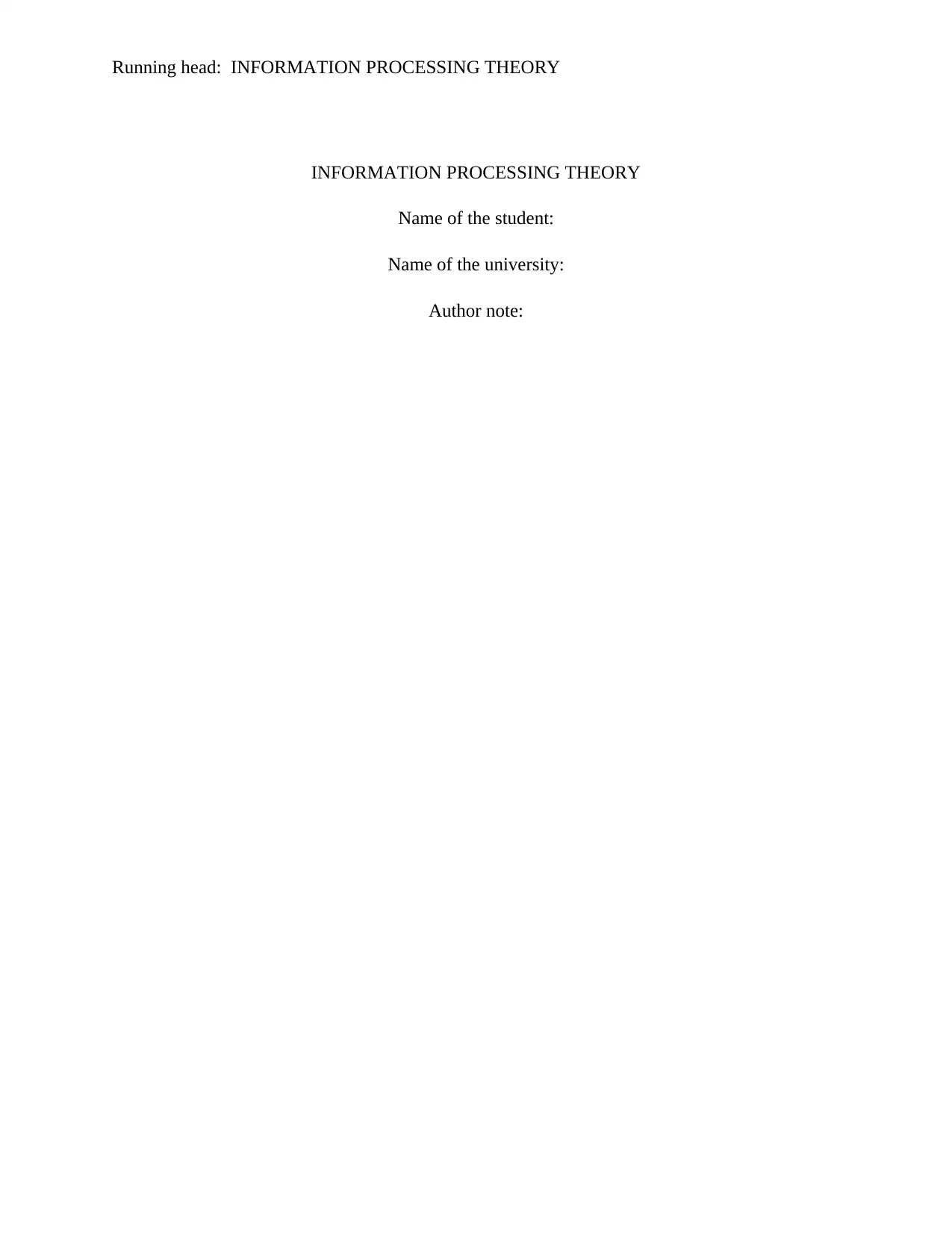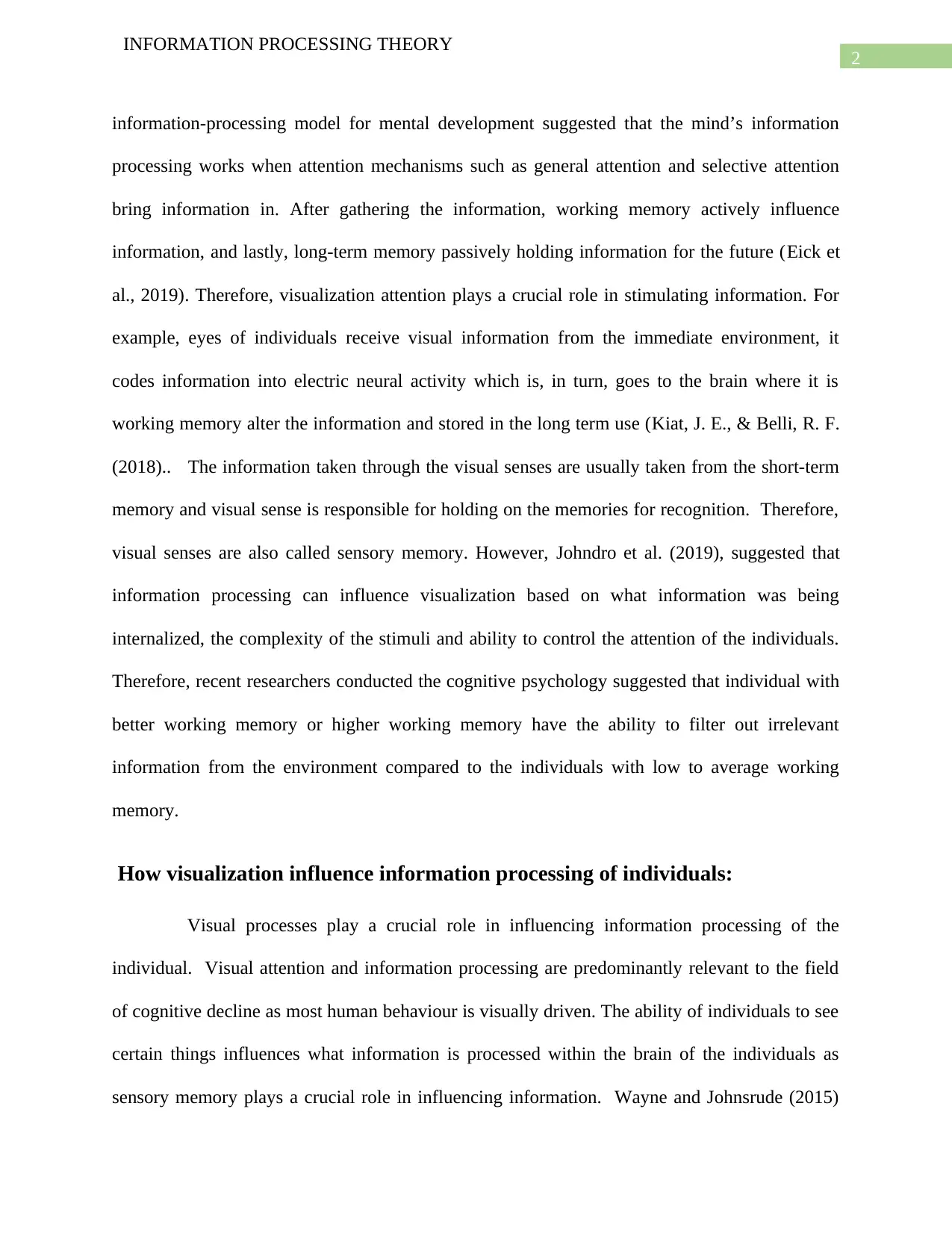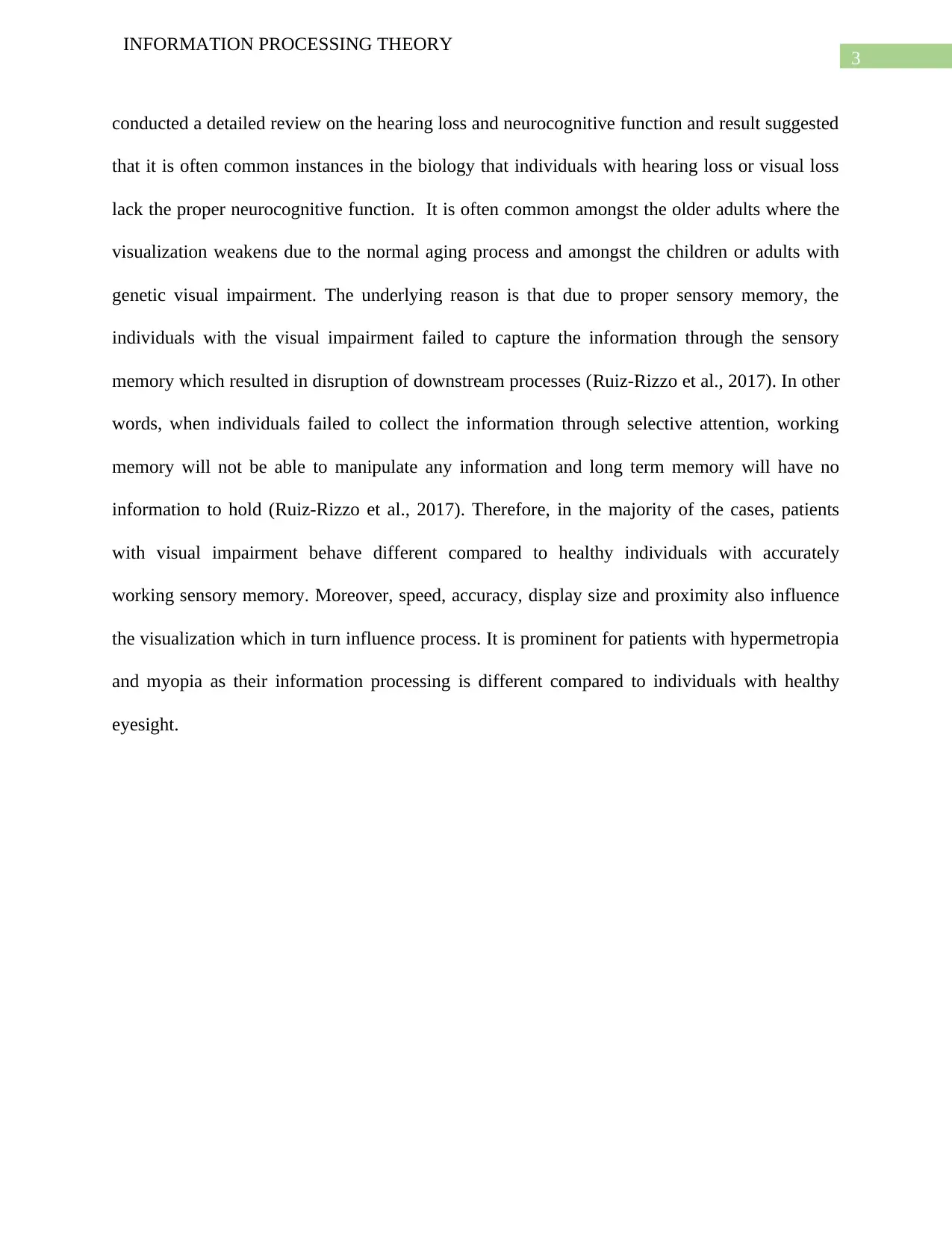Essay on Information Processing Theory and Visual Processing
VerifiedAdded on 2022/09/14
|6
|1236
|21
Essay
AI Summary
This essay provides an overview of the information processing theory, a cognitive theory used to assess mental development. It explains the theory's origins, its assumptions, and its application in understanding how the human brain processes information. The essay explores the role of visualization in information processing, discussing how visual attention, sensory memory, and working memory are interconnected. It highlights the influence of visual processes on information processing, particularly in the context of cognitive decline and visual impairments. The essay references studies on hearing loss, visual impairment, and the effects of visualization on cognitive functions. It concludes by emphasizing the importance of visualization in influencing the information processing of individuals and the impact of factors like speed, accuracy, display size, and proximity on this process. The essay uses various sources to support the claims.

Running head: INFORMATION PROCESSING THEORY
INFORMATION PROCESSING THEORY
Name of the student:
Name of the university:
Author note:
INFORMATION PROCESSING THEORY
Name of the student:
Name of the university:
Author note:
Paraphrase This Document
Need a fresh take? Get an instant paraphrase of this document with our AI Paraphraser

1
INFORMATION PROCESSING THEORY
Information processing theory:
It is a cognitive theory was adopted by Developmental psychologists for assessing the
mental development of a child based on the basic component of the brain. It was developed by a
cognitive psychologist George A. Miller to provide individuals with a basic idea of how the
human brain process information. Information Processing Theory is at present being applied in
artificial intelligence for facilitating the human working process. The theory is conceptualize the
cognitive process of the human being and suggested that humans being processed every
knowledge human being receive, rather than responding to environmental stimuli. It is based on
four basic assumptions (Lee & Chatzisarantis, 2017). First, the information presented in the
surroundings processed by a range of processing system such as attention, short-term memory
(Xiong & Proctor, 2018). Second, these processing systems have the ability to alter the evidence
in a systematic way of obtaining the best possible interpretation. Third, the theory adopted by
the researchers for specifying the processes and structure that facilitate cognitive performance.
Last, information processing in humans being nearly resembled that in computers. Therefore, in
the period of 1950s - 1960s, the advancement of the computer had a significant impact on
psychology. It opened a new avenue for research for the cognitive approach and it became the
leading approach in psychology specially overpowering Behaviorism. The underlying reason is
that computer development provided scientists with a process of how the human mind works
when it captures information from the environment.
Role of Information processing theory in visualizing processing:
Kret and Bocanegra (2016), suggested that standard information-processing model is one
of the most common models used for explaining how information processing works. Standard
INFORMATION PROCESSING THEORY
Information processing theory:
It is a cognitive theory was adopted by Developmental psychologists for assessing the
mental development of a child based on the basic component of the brain. It was developed by a
cognitive psychologist George A. Miller to provide individuals with a basic idea of how the
human brain process information. Information Processing Theory is at present being applied in
artificial intelligence for facilitating the human working process. The theory is conceptualize the
cognitive process of the human being and suggested that humans being processed every
knowledge human being receive, rather than responding to environmental stimuli. It is based on
four basic assumptions (Lee & Chatzisarantis, 2017). First, the information presented in the
surroundings processed by a range of processing system such as attention, short-term memory
(Xiong & Proctor, 2018). Second, these processing systems have the ability to alter the evidence
in a systematic way of obtaining the best possible interpretation. Third, the theory adopted by
the researchers for specifying the processes and structure that facilitate cognitive performance.
Last, information processing in humans being nearly resembled that in computers. Therefore, in
the period of 1950s - 1960s, the advancement of the computer had a significant impact on
psychology. It opened a new avenue for research for the cognitive approach and it became the
leading approach in psychology specially overpowering Behaviorism. The underlying reason is
that computer development provided scientists with a process of how the human mind works
when it captures information from the environment.
Role of Information processing theory in visualizing processing:
Kret and Bocanegra (2016), suggested that standard information-processing model is one
of the most common models used for explaining how information processing works. Standard

2
INFORMATION PROCESSING THEORY
information-processing model for mental development suggested that the mind’s information
processing works when attention mechanisms such as general attention and selective attention
bring information in. After gathering the information, working memory actively influence
information, and lastly, long-term memory passively holding information for the future (Eick et
al., 2019). Therefore, visualization attention plays a crucial role in stimulating information. For
example, eyes of individuals receive visual information from the immediate environment, it
codes information into electric neural activity which is, in turn, goes to the brain where it is
working memory alter the information and stored in the long term use (Kiat, J. E., & Belli, R. F.
(2018).. The information taken through the visual senses are usually taken from the short-term
memory and visual sense is responsible for holding on the memories for recognition. Therefore,
visual senses are also called sensory memory. However, Johndro et al. (2019), suggested that
information processing can influence visualization based on what information was being
internalized, the complexity of the stimuli and ability to control the attention of the individuals.
Therefore, recent researchers conducted the cognitive psychology suggested that individual with
better working memory or higher working memory have the ability to filter out irrelevant
information from the environment compared to the individuals with low to average working
memory.
How visualization influence information processing of individuals:
Visual processes play a crucial role in influencing information processing of the
individual. Visual attention and information processing are predominantly relevant to the field
of cognitive decline as most human behaviour is visually driven. The ability of individuals to see
certain things influences what information is processed within the brain of the individuals as
sensory memory plays a crucial role in influencing information. Wayne and Johnsrude (2015)
INFORMATION PROCESSING THEORY
information-processing model for mental development suggested that the mind’s information
processing works when attention mechanisms such as general attention and selective attention
bring information in. After gathering the information, working memory actively influence
information, and lastly, long-term memory passively holding information for the future (Eick et
al., 2019). Therefore, visualization attention plays a crucial role in stimulating information. For
example, eyes of individuals receive visual information from the immediate environment, it
codes information into electric neural activity which is, in turn, goes to the brain where it is
working memory alter the information and stored in the long term use (Kiat, J. E., & Belli, R. F.
(2018).. The information taken through the visual senses are usually taken from the short-term
memory and visual sense is responsible for holding on the memories for recognition. Therefore,
visual senses are also called sensory memory. However, Johndro et al. (2019), suggested that
information processing can influence visualization based on what information was being
internalized, the complexity of the stimuli and ability to control the attention of the individuals.
Therefore, recent researchers conducted the cognitive psychology suggested that individual with
better working memory or higher working memory have the ability to filter out irrelevant
information from the environment compared to the individuals with low to average working
memory.
How visualization influence information processing of individuals:
Visual processes play a crucial role in influencing information processing of the
individual. Visual attention and information processing are predominantly relevant to the field
of cognitive decline as most human behaviour is visually driven. The ability of individuals to see
certain things influences what information is processed within the brain of the individuals as
sensory memory plays a crucial role in influencing information. Wayne and Johnsrude (2015)
⊘ This is a preview!⊘
Do you want full access?
Subscribe today to unlock all pages.

Trusted by 1+ million students worldwide

3
INFORMATION PROCESSING THEORY
conducted a detailed review on the hearing loss and neurocognitive function and result suggested
that it is often common instances in the biology that individuals with hearing loss or visual loss
lack the proper neurocognitive function. It is often common amongst the older adults where the
visualization weakens due to the normal aging process and amongst the children or adults with
genetic visual impairment. The underlying reason is that due to proper sensory memory, the
individuals with the visual impairment failed to capture the information through the sensory
memory which resulted in disruption of downstream processes (Ruiz-Rizzo et al., 2017). In other
words, when individuals failed to collect the information through selective attention, working
memory will not be able to manipulate any information and long term memory will have no
information to hold (Ruiz-Rizzo et al., 2017). Therefore, in the majority of the cases, patients
with visual impairment behave different compared to healthy individuals with accurately
working sensory memory. Moreover, speed, accuracy, display size and proximity also influence
the visualization which in turn influence process. It is prominent for patients with hypermetropia
and myopia as their information processing is different compared to individuals with healthy
eyesight.
INFORMATION PROCESSING THEORY
conducted a detailed review on the hearing loss and neurocognitive function and result suggested
that it is often common instances in the biology that individuals with hearing loss or visual loss
lack the proper neurocognitive function. It is often common amongst the older adults where the
visualization weakens due to the normal aging process and amongst the children or adults with
genetic visual impairment. The underlying reason is that due to proper sensory memory, the
individuals with the visual impairment failed to capture the information through the sensory
memory which resulted in disruption of downstream processes (Ruiz-Rizzo et al., 2017). In other
words, when individuals failed to collect the information through selective attention, working
memory will not be able to manipulate any information and long term memory will have no
information to hold (Ruiz-Rizzo et al., 2017). Therefore, in the majority of the cases, patients
with visual impairment behave different compared to healthy individuals with accurately
working sensory memory. Moreover, speed, accuracy, display size and proximity also influence
the visualization which in turn influence process. It is prominent for patients with hypermetropia
and myopia as their information processing is different compared to individuals with healthy
eyesight.
Paraphrase This Document
Need a fresh take? Get an instant paraphrase of this document with our AI Paraphraser

4
INFORMATION PROCESSING THEORY
References:
Eick, C. M., Ahmadi, K., Sweeney-Reed, C. M., & Hoffmann, M. B. (2019). Interocular transfer
of visual memory–Influence of visual impairment and abnormalities of the optic
chiasm. Neuropsychologia, 129, 171-178.
Johndro, H., Jacobs, L., Patel, A. D., & Race, E. (2019). Temporal predictions provided by
musical rhythm influence visual memory encoding. Acta psychologica, 200, 102923.
Kiat, J. E., & Belli, R. F. (2018). The role of individual differences in visual\verbal information
processing preferences in visual\verbal source monitoring. Journal of Cognitive
Psychology, 30(7), 701-709.
Kret, M. E., & Bocanegra, B. R. (2016). Adaptive hot cognition: How emotion drives
information processing and cognition steers affective processing. Frontiers in
psychology, 7, 1920.
Lee, R. R., & Chatzisarantis, N. L. (2017). Same but different: Comparative modes of
information processing are implicated in the construction of perceptions of autonomy
support. British Journal of Psychology, 108(4), 687-700.
Ruiz-Rizzo, A. L., Bublak, P., Redel, P., Grimmer, T., Müller, H. J., Sorg, C., & Finke, K.
(2017). 7. Study 3: Visual processing speed and complex object perception in
pathological aging. Visual Processing Speed in the Aging Brain, 120.
Wayne, R. V., and Johnsrude, I. S. (2015). A review of causal mechanisms underlying the link
between age-related hearing loss and cognitive decline. Ageing Res. Rev. 23, 154–166.
doi: 10.1016/j.arr.2015.06.002
Xiong, A., & Proctor, R. W. (2018). Information processing: The language and analytical tools
for cognitive psychology in the information age. Frontiers in psychology, 9, 1270.
INFORMATION PROCESSING THEORY
References:
Eick, C. M., Ahmadi, K., Sweeney-Reed, C. M., & Hoffmann, M. B. (2019). Interocular transfer
of visual memory–Influence of visual impairment and abnormalities of the optic
chiasm. Neuropsychologia, 129, 171-178.
Johndro, H., Jacobs, L., Patel, A. D., & Race, E. (2019). Temporal predictions provided by
musical rhythm influence visual memory encoding. Acta psychologica, 200, 102923.
Kiat, J. E., & Belli, R. F. (2018). The role of individual differences in visual\verbal information
processing preferences in visual\verbal source monitoring. Journal of Cognitive
Psychology, 30(7), 701-709.
Kret, M. E., & Bocanegra, B. R. (2016). Adaptive hot cognition: How emotion drives
information processing and cognition steers affective processing. Frontiers in
psychology, 7, 1920.
Lee, R. R., & Chatzisarantis, N. L. (2017). Same but different: Comparative modes of
information processing are implicated in the construction of perceptions of autonomy
support. British Journal of Psychology, 108(4), 687-700.
Ruiz-Rizzo, A. L., Bublak, P., Redel, P., Grimmer, T., Müller, H. J., Sorg, C., & Finke, K.
(2017). 7. Study 3: Visual processing speed and complex object perception in
pathological aging. Visual Processing Speed in the Aging Brain, 120.
Wayne, R. V., and Johnsrude, I. S. (2015). A review of causal mechanisms underlying the link
between age-related hearing loss and cognitive decline. Ageing Res. Rev. 23, 154–166.
doi: 10.1016/j.arr.2015.06.002
Xiong, A., & Proctor, R. W. (2018). Information processing: The language and analytical tools
for cognitive psychology in the information age. Frontiers in psychology, 9, 1270.

5
INFORMATION PROCESSING THEORY
INFORMATION PROCESSING THEORY
⊘ This is a preview!⊘
Do you want full access?
Subscribe today to unlock all pages.

Trusted by 1+ million students worldwide
1 out of 6
Related Documents
Your All-in-One AI-Powered Toolkit for Academic Success.
+13062052269
info@desklib.com
Available 24*7 on WhatsApp / Email
![[object Object]](/_next/static/media/star-bottom.7253800d.svg)
Unlock your academic potential
Copyright © 2020–2025 A2Z Services. All Rights Reserved. Developed and managed by ZUCOL.





